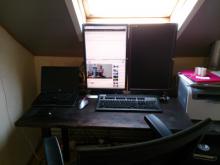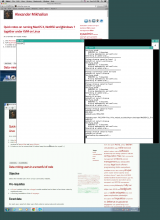Forget fast boot times. fast wake-up and network up is what matters
It takes me ~8 seconds from the key press to a fully functional environment.
It takes me ~8 seconds from the key press to a fully functional environment.

It's not a coincidence that notebook docking stations are being sold only with high-end laptops. My Dell e7740 costs over 2000 €. When I bought it in January 2014, I couldn't imagine I'll have trouble making it work under Linux. After all, it was all-intel, already well-supported hardware. The trouble came from a usually dumb piece of hardware: the docking station. I run two 1920x1200 screens in portrait mode, but this freaking docking station"intelligently" merged the two screens into a virtual 3840x1200 screen and presented just that to the notebook.
The bug-o-feature responsible for this is called Displayport Multi-Stream Transport and it was intended to drive multiple displays via one cable using daisy-chaining. When first docking stations with MST support appeared by end 2013, none was prepared for it. It took well over a year before MST support landed in mainline 3.17 kernel. And it will take another year until all major distributions move to 3.17 and past it.
Red Hat itself found it out only when they run into the problem, and it took 6 months before David Airlie came up with a patch to fix this hardware bug. Check out this talk for a good overview of the story.

As a reminder for myself, mostly:
The cluster runs on apt-based systems. It is designed for high-availability: failure of one server is not critical. However, there is no automatic failover configuration. Instead, manual recovery is possible within minutes.
All servers set up exim to work as smarthost, sending mails through gmail. In practice, gmail limits outgoing emails to a few thousands per day, so it is better to replace it by a dedicated solution such as Mailchimp. There's also newrelic for server monitoring on all servers.
The playbook assumes that all servers have public IPs on eth0 and sit in the private network on eth1.
For the rest, check the code in github.
How it should work:
To label an ext3/ext4 disk, use
e2label device [newlabel]
Then, create an udev rule that runs your script when you insert a disk with a partition named backup:
echo 'KERNEL=="sd*", ENV{ID_FS_LABEL}=="backup", RUN+="/usr/local/bin/backup.sh"'
>> /etc/udev/rules.d/99-backup.rules
your backup script can be as simple as this:
#!/bin/sh /bin/mount /dev/disk/by-label/backup /media/backup && \ /usr/bin/rsync -r /home/* /media/backup && \ /bin/umount /media/backup && \ /usr/bin/beep
Watch out, $PATH is not set, you shoud use absolute paths everywhere.
To make it all work, reload udev rules with
udevadm control --reload-rules
Internet trolls are using Tor nowadays to avoid bans by IP. However, banning Tor exit nodes is just slightly more complex. The Tor Project provides a regularly updated list of exit nodes that can access your IP here. As there may be many hundreds or even thousands of nodes, adding them to iptables can hurt your server's network performance. Enter ipset, a user-space hash table for iptables:
# create a new set for individual IP addresses ipset -N tor iphash # get a list of Tor exit nodes that can access $YOUR_IP, skip the comments and read line by line wget -q https://check.torproject.org/cgi-bin/TorBulkExitList.py?ip=$YOUR_IP -O -|sed '/^#/d' |while read IP do # add each IP address to the new set, silencing the warnings for IPs that have already been added ipset -q -A tor $IP done # filter our new set in iptables iptables -A INPUT -m set --match-set tor src -j DROP
Assuming that the internal screen is LVDS and the external screen is DVI-0. inotifywait comes from the inotify-tools package.
# Wait for the changes detected by the kernel laptop mode.
while inotifywait -e modify /proc/sys/vm/laptop_mode
do
laptop_mode=`cat /proc/sys/vm/laptop_mode`
# If on battery, switch on the internal screen.
if [[ $laptop_mode -gt 0 ]]; then
xrandr --output LVDS --mode 1280x800
xrandr --output DVI-0 --off
# Otherwise,
elif [[ $laptop_mode = 0 ]]; then
# if the external screen is connected, switch it on.
if [[ `xrandr -q|grep DVI-0|cut -f2 -d\ ` = connected ]]; then
xrandr --output DVI-0 --mode 1920x1200
xrandr --output LVDS --off
fi
fi
done
I recently bought an Asrock ION 330 Pro HTPC which supports VDPAU, an NVIDIA API for Linux that offloads parts of video processing to the GPU. The upgrade from the old HTPC went smoothly with a mere dd if=/dev/sda of=/dev/sdb and a few system tweaks. However, it turned out that Mplayer in Debian Lenny that I was running on my new HTPC box did not support VDPAU. Checking the usual places, like backports and debian-multimedia did not help, either.
A bad sysadmin changes the default SSH port.
A good sysadmin throttles the brute-force attackers by allowing one new connection in 20 seconds.
# requires xt_TARPIT iptables -A INPUT -p tcp -m state --state NEW \ --dport 22 -m recent --update --seconds 20 -j TARPIT iptables -A INPUT -p tcp -m state --state NEW \ --dport 22 -m recent --set -j ACCEPT
A brilliant sysadmin blocks intruders indefinitely
# requires hashlimit iptables -A INPUT -p tcp -m tcp --dport 22 -m state \ --state NEW -m hashlimit --hashlimit 1/hour \ --hashlimit-burst 2 --hashlimit-mode srcip \ --hashlimit-name SSH --hashlimit-htable-expire 60000 -j ACCEPT iptables -A INPUT -p tcp -m tcp --dport 22 \ --tcp-flags SYN,RST,ACK SYN -j DROP iptables -A INPUT -p tcp -m state \ --state NEW -m tcp --dport 22 -j ACCEPT
In the last example, the 1st rule allows up to two connections per hour. After the limit of two connections per hour is reached, the second rule becomes active and the hashlimit module starts to countdown from 1 minute (60 000 milliseconds). If you connect within 1 minute, the hashlimit counter is reset to 60 000. If you connect after 1 minute, you drop to the 3rd rule and are allowed access.
Cherry-picked from Habr